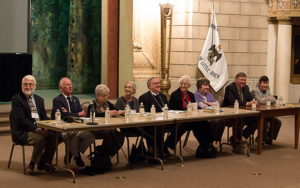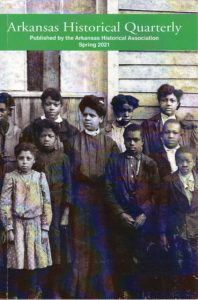calsfoundation@cals.org
Arkansas History’s Ecosystem—and Your Place in It
The history community is like an ecosystem, with its various parts drawing energy and nutrition from other areas and, in turn, contributing energy and nutrition to other parts in ways that might not be immediately perceptible.
 This is a reality that confronts me nearly every day. You see, the CALS Encyclopedia of Arkansas does not exist, could not exist, absent the presence of numerous other institutions, such as local historical societies, university and college archives, public libraries, the Arkansas Historical Association, and many more. If the EOA were an organism, we might be one of those creatures on the seafloor, waiting patiently for the remains of fish and whales to drift their way.
This is a reality that confronts me nearly every day. You see, the CALS Encyclopedia of Arkansas does not exist, could not exist, absent the presence of numerous other institutions, such as local historical societies, university and college archives, public libraries, the Arkansas Historical Association, and many more. If the EOA were an organism, we might be one of those creatures on the seafloor, waiting patiently for the remains of fish and whales to drift their way.
But that’s not really the best analogy, is it? Those worms exist outside the sphere of most other organisms on the planet, while, within the state history community at least, the EOA is one of the most used and trusted resources, hardly a shy annelid on the bottom of the seafloor.
What I mean by trying to describe the history community as a complex ecosystem is this:
As the editor of the EOA, I am perpetually aware of how much we draw from the Arkansas Historical Association and local historical societies. In its more than eighty years of existence, the Arkansas Historical Quarterly has published a tremendous body of reliable historical work that has been used to provide the source material for a wealth of our entries, and which we regularly use to fact check entries in progress. When each new issue arrives, I tear it open to see what articles I need to add to entry bibliographies, as well as what new entry topics I need to develop. The yearly Arkansas Historical Association conference has been a boon to us in terms of meeting new and established scholars and recruiting them for future EOA writing assignments.

The AHA is the premier organization dedicated to the preservation and dissemination of Arkansas history.
But the AHA itself could not exist without the hard work of many other institutions, such as the archives that preserve the documents historians draw from and the libraries that make scholarship accessible to the public. Let’s not forget local historical associations, either. Arkansas has a number of county and local historical societies that have regularly taken the lead in both preserving historical structures and publishing journals and books about the history of the area. Our lived surroundings are often what draw us to an appreciation of history in the first place, what creates in us a sense of the importance of the past and how that past shapes the world we inhabit today.
County historical societies have not just been the drivers of local history but also of state history, for you cannot understand local developments without an understanding of the state, and so many such societies have worked to build local collections of books on Arkansas history, often housed at the local library. When I was growing up in Jonesboro, the Craighead County Jonesboro Public Library had its “Arkansas Room,” packed with books and various documents.
County libraries, too, were early heroes in the efforts to preserve local newspapers. Many of these titles have since been microfilmed and even digitized, but county libraries continue to make these available by subscribing to the databases necessary to access them.
So the EOA is tremendously dependent upon the Arkansas Historical Association and county historical societies, themselves dependent upon archives and libraries, as well as…the EOA.
 That’s right—we don’t just draw into this system but feed back into it. The scope and reliability of the EOA serve to make it a great tool for fact checking, which is important when, say, the Arkansas Historical Quarterly is reviewing another article or the local historical society is planting another marker. Plus, the wealth and interconnectivity of information available on the EOA make it possible to write much more robust local history, as it becomes easier to draw connections between certain personalities and events and places. And then, down the line, we will ultimately draw energy from all this new activity, improving the EOA in response to what has been developed.
That’s right—we don’t just draw into this system but feed back into it. The scope and reliability of the EOA serve to make it a great tool for fact checking, which is important when, say, the Arkansas Historical Quarterly is reviewing another article or the local historical society is planting another marker. Plus, the wealth and interconnectivity of information available on the EOA make it possible to write much more robust local history, as it becomes easier to draw connections between certain personalities and events and places. And then, down the line, we will ultimately draw energy from all this new activity, improving the EOA in response to what has been developed.
The lines of interrelationship are so exciting and complex that it would fall flat to call this a “circle of life.” Maybe a multidimensional “dodecahedron of inspiration.”
We have, in the past, asked you to contribute your time, talents, or money to the EOA project, and we will certainly ask again in the future. But I also want you to do something else that would benefit the EOA down the line. If you are not already a member of the Arkansas Historical Association, please become one now. Twenty dollars a year gets you four issues of the fascinating Arkansas Historical Quarterly and access to conference announcements and more. It is easily the best value in Arkansas history around.
Too, if there is a local historical society in your area, become a member. Here is a list of county historical societies in Arkansas. A lot of exciting work is being done at the county level. You should be involved.
If the EOA is truly to continue to get better, then we need strong and dedicated state and local historical societies. The history community is, indeed, like an ecosystem, precariously balanced. Sometimes, the removal of one species is enough to wreck it. Preserve Arkansas’s history. Preserve the EOA. And get involved.
By Guy Lancaster, editor of the CALS Encyclopedia of Arkansas



